Milan boasts a robust public transit infrastructure that makes getting about the city easy and economical. ATM, which runs a wide network of buses, trams, and metro lines, manages public transportation. In the city, there are more than 300 bus routes that run continuously from early in the morning to late at night. There are 5 lines in the Milan Metro, with line M5 being the most recent to open in 2014. The city center and its surrounds are covered by the 8 lines that make up the tram system. Cities in the Lombardy region can also be reached by a number of regional trains. In Milan, all public transportation options are interconnected, making it feasible to purchase a single ticket for use throughout the whole network.
Metro system in Milan – Basic information
Milan, Italy’s metro system is made up of five lines that span more than 100 kilometers of track and more than 100 stops. Azienda Trasporti Milanesi (ATM) runs the Metro system, which is open from five in the morning until midnight. A single Metro, bus, or tram ticket costs €1.50 and is good for up to 90 minutes of travel.
The lines of the Milan subway system
Line 1 – Red (Linea Uno – Rossa)
Line 1 is the designation given to the very first underground rapid transit line that was built in Milan, Italy. This station is a component of the Milan Metro and is operated by ATM. The building of the line began in 1957, and on November 1, 1964, the first leg of the line, which stretched from the Sesto Marelli station to the Lotto station, was opened to the public. The line is sometimes referred to as the Red Line due to the red signs that are used to visually differentiate it from other lines. Due to the fact that it was the very first line, the color red was chosen to represent the Milan Metro emblem.
Line 2 – Green (Linea Due – Verde)
The line has two separate branches as it runs from the southern to the north-eastern neighborhoods as it passes through the city center. These branches both provide service to the northeastern metropolitan area. Along the length of the 39.4 kilometer long route, there are 35 stations. Line 2 of the Milan Metro is the longest line in the system and also the only one that travels partially above ground. The branch that goes to Cologno Nord travels mostly on viaducts, in contrast to the branches that go to Assago and Gessate, which travel primarily on the ground. This line contains the Assago Forum and Gessate stations, which are the most southern and eastern stations of the network, respectively.
Line 3 – Yellow (Linea Tre – Gialla)
This segment of the Milan Metro is operated by ATM and serves as a component of the system. Construction work on the stadium began in 1981 in order to ensure that it would be ready for the FIFA World Cup in 1990. Because the boundary between the two parking lots is designated with yellow signage, it is often referred to as the Yellow Line. One of the city’s suburbs, San Donato Milanese, is located to the southeast, and the city’s northwestern part is located to the north of the city center. Along its length of 17.1 kilometers, it features 21 stops in total.
Line 4 – Blue (Linea Azura)
It is predicted that the entire route will be open by the year 2023, with the first portion of the route commencing service on November 26, 2022. The line will feature 21 stations and be 15 kilometers long when it is finished, an increase from the current 6 stops that are operational along the route. The route utilizes driverless, autonomous trains that have a capacity of between 24,000 and 28,001 passengers per hour in each direction. There need to be 87 million riders each and every year.
Line 5 – Lilac (Linea Lilla)
Line 5 of the Milan Metro is a rapid transit line that operates underground and is a component of the Milan Metro in Milan, Italy. From the north to the northwest, the Lilac Line, which is 12.8 kilometers long and is also known as the M5 or the Lilac Line, traverses the city from east to west. Between 2013 and 2015, it began to open to the public in stages. On this route, driverless AnsaldoBreda Metro cars serve as the mode of transportation.
Map of Milan Metro 2023 – Free Download in PDF
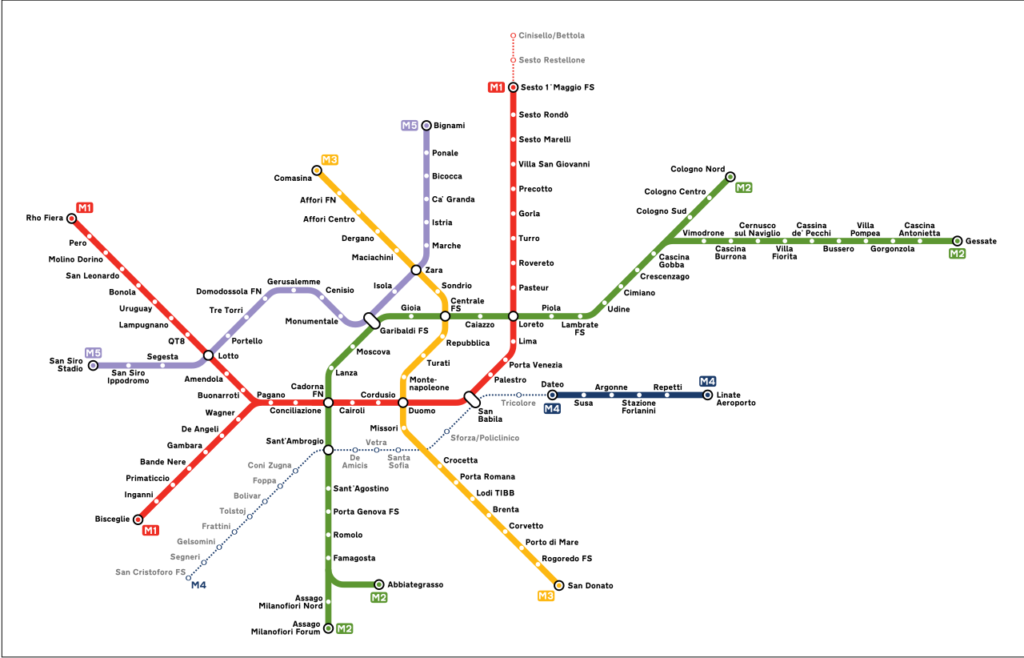
Click and download the map of Milan’s underground system for 2023
You may now download the Milan Metro Map 2023 for free in PDF format. This detailed map displays every route, station, and connection in the Milan Metro network. It is a great tool that enables users to swiftly and easily traverse the intricate Milan Metro system, which benefits both commuters and tourists. The Milan Metro Map 2023 is a need for anyone trying to navigate the city due to its user-friendly design and current information. Don’t worry about getting lost in the city ever again by obtaining your free copy today!
Public transport tickets in Milan – Best types for travelers & actual prices
A single-use ticket is the most popular choice for public transit in Milan. These are on-demand tickets that are good for a single bus, tram, or metro travel. A single ticket costs €2.00, while a book of four tickets costs €5.00.
Consider buying a pass if you intend to take the Milan public transportation system more than once. Day passes, weekly passes, and monthly passes are the three different types of passes that are offered. Day passes cost €5.00 and are good for 24 hours after being stamped. Weekly passes cost €12.00 and are good for seven days starting on the day they are stamped. Monthly passes cost €35.00 and are good for 30 days after the date they are stamped.
A three-day pass is the ideal choice for visitors to Milan. These passes cost €15.00 and are good for 72 hours after being stamped. For those who will be in town for no more than three days, this is the most affordable choice.
Overall, Milan has a selection of public transit tickets alternatives. The most popular choice is single-use tickets, but if you intend to take public transit frequently, you might want to think about getting a pass. The three-day pass, which costs €15.00 and is good for 72 hours from the time it is issued, is the best choice for visitors who will be there for three days or less.
Summary of fares for public transport in Milan
- The most common type of public transportation ticket in Milan is the single-use ticket, which costs €2.00 per ticket or €5.00 for a book of four.
- If you plan to use the Milan public transportation system more than once, passes are available:
- Day passes cost €5, are valid for 24 hours,
- Weekly cards cost €12, and are valid for 7 days
- Monthly passes cost €35, and are valid for 30 days
- For travelers to Milan, three-day permits (€15.00, valid for 72 hours) are the best option.
Timetables & Schedules of Milan Metro system
In the Italian city of Milan, there is a vast network of lines that make up the Milan Metro system. The Metro runs trains from 5:30 am to 12:30 am on weekdays and from 6:00 am to 12:30 am on weekends and holidays, which is a very handy timetable. It is simple to get around the city because the Metro operates every 10-15 minutes during off-peak hours and every 8 minutes during peak hours. Additionally, the Metro offers free Wi-Fi to its users and is accessible to wheelchair users.
What Are Other Options For Public Transportation In Milan?
In addition to the metro, Milan has a number of other public transit options. These include trolleys, buses, and trams. There are more than 200 routes available on the bus network, which serves the entire city and its surroundings. With 18 lines that travel through the city’s principal streets, the trams are primarily restricted to the city center. Additionally, there are four trolley routes that primarily circle the city’s outside. Milan also provides cabs and bike-sharing programs for individuals who require more flexible transit options.
how does the public bus transportation work in Milan
The Azienda Trasporti Milanesi (ATM), one of the largest networks in Europe, is in charge of managing public bus transit in Milan. 4,500 buses operate on the system’s more than 200 bus routes, which has a total of over 200 bus lines. To better meet the needs of both locals and visitors, the bus lines are separated into urban and suburban lines.
Urban lines go through the heart of the city and are color-coded to show where they go. The city’s west is served by blue lines, while the east is served by green lines. The north is served by red lines, and the south is served by yellow lines. The 91, 94, 73, and 75 are Milan’s most popular urban bus routes.
Extra-urban and inter-urban lines are the two types of suburban lines. Inter-urban lines link Milan with other cities in the area, while extra-urban lines service the city’s periphery. The S9, S13, S5, S11, and S14 are the suburban bus lines in Milan that are most often utilized.
Additionally, the ATM provides a range of specialized services like shuttle buses, rapid buses, and night buses. In general, night buses are only accessible from 10 p.m. to 5 a.m. on a set schedule. Express buses have a yellow stripe on their side and are speedier than regular buses. The last option is shuttle buses, which may transport people to and from the airport.
How do the public TRAINS work in Milan?
Milan is a stunning Italian city well-known for its history, culture, and fashion. Trains are among the most well-liked modes of transit in the city’s enormous public transportation network. This article will go over Milan’s public transportation system and the key connections to other adjacent cities.
Centrale Station, Porta Garibaldi Station, and Rogoredo Station are Milan’s three primary train stations. The largest station in Milan, Centrale Station, has connections to many other Italian cities. Located in the city’s northeast, Porta Garibaldi Station connects to towns in Lombardy, Veneto, and Emilia Romagna. Last but not least, Rogoredo Station, which lies southeast of the city, connects to towns in Tuscany and Liguria.
Trenitalia, which offers a variety of services, runs the trains in Milan. The most prevalent kind of train is a regional train, which stops at every station along the way. For commuters and tourists who need to get from one place to another swiftly and economically, the regional train is ideal. In addition to regional trains, Trenitalia also runs high-speed trains, which are quicker and make fewer stops. For passengers who wish to reach their destination without having to make numerous stops, these trains are the best option.
Milan has some of the most crucial train links to other Italian cities like Rome, Bologna, and Turin. Additionally, there are connections to Paris, Barcelona, and Zurich as well as other destinations in other European nations. In addition, Milan has direct train links to the region’s busiest airports, including Linate and Malpensa.
Overall, using public transportation to go around Milan and the neighboring areas is effective and economical. Trenitalia, which operates trains, provides a range of services, including high-speed trains and regional trains. Milan has some of the most crucial train connections to other Italian cities as well as cities across other European nations. Milan also offers direct train links to the region’s biggest airports.
How To Get From Milano Malpensa Airport (MXP) To The City Center With Public Transport?
Taking the Malpensa Express train is the most practical way to go from Milano Malpensa Airport to the city center. Every 30 minutes, the train leaves from Terminal 1 of the airport and takes around 40 minutes to reach the city center. At the ticket office or the ticket machines situated in the arrivals area of the airport, passengers can purchase train tickets.
Taking the bus from the airport to the city center is an additional alternative. The Autostradale bus is the most well-liked of the bus routes that connect the airport and the city center. The bus leaves from Terminal 1 of the airport and travels for roughly an hour before reaching the city’s core. Both the ticket office and the ticket machines in the arrivals area of the airport sell bus tickets.
how to spend 3 days in Milan?
Milan is the ideal location if you’re searching for a distinctive experience in one of the world’s fashion hubs. You can tour this dynamic city and all of its attractions in just three days. Here’s how to have a special stay in Milan.
First day
Take a tour of Milan’s famous Duomo to kick off your trip. The largest Gothic cathedral in Italy, this majestic structure has a rooftop patio with breathtaking city views. Explore the city’s historic core afterward to see the intriguing museums, remains from the Roman era, and bustling squares. Dinner should be had in the Navigli neighborhood in the evening. There are many excellent local eateries in this region where you may try authentic Italian food.
2nd day
Explore Milan’s fashion houses on the second day. Take a guided tour of some of the city’s well-known shopping areas, like the Quadrilatero della Moda, to see the newest designer labels and upscale stores. Experience Milan’s nightlife in the evening. The lively ambiance of the city’s pubs and clubs may be experienced when strolling down the Corso Como.
A third day
Go on a day trip to one of the neighboring lakes on your final day in Milan. Beautiful landscapes and a variety of activities, including hiking, sailing, and swimming, can be found at Lake Como and Lake Garda. Visit the La Scala opera theatre to see a performance of one of the most well-known operas in the world to round off your journey.
What other metro systems are nearby to Milan?
Modern metro lines connect Milan to other cities, but those who want to explore the area can also use other adjacent metro lines. The towns of Bologna and Verona are also within a few hours’ drive, as is the metro system of Genoa and Metropolitana di Torino. Furthermore, Milan is a fantastic choice for anyone wishing to explore even more because Lake Como, a well-known tourist attraction, is only a short train trip away. It is simple to experience the culture and natural beauty of Northern Italy because there are so many metro systems nearby.
Summary of our tour guide for Milan
In Milan, I’ve used the public transit system a lot. The public transit system was the simplest and most effective way for me to get around when I initially moved to the city for a semester of study abroad. I traveled to and from classes, work, and other destinations using buses, trams, and metro trains. I was able to get where I needed to go without any difficulty because the system worked as it should and the costs were reasonable. If you’re traveling or residing in Milan, I would strongly advise using the public transit system since it’s a great way to move around the city without having to worry about traffic or parking.
Top 5 FAQs and answers about Milan public transport?
What kinds of public transportation are offered?
- Milan has a comprehensive system of public transportation that includes buses, trams, subway trains, and suburban trains. The regional railroad business Trenord operates the trams, while ATM, the city’s public transportation provider, operates the buses. Milan also boasts a system of underground trains that connects the city center to the nearby cities and suburbs. Other cities in Lombardy and other parts of Italy can be reached by suburban trains from Milan.
How much does using Milan’s public transportation cost?
- For a single trip, the usual fare for buses and trams is €1.50. Additionally, there are travel passes available that provide savings on several trips. Trenord runs the suburban and underground trains, and the cost is determined by the distance covered.
Is there an app that can guide me through the public transportation system?
- Yes, the official ATM app offers full network maps as well as the most recent information on bus and tram schedules. Additionally, it provides journey planning, real-time arrivals, and alerts for delays and disruptions.
Is Milan’s public transportation system secure to use?
- In general, Milan’s public transportation system is dependable and secure. However, it is always recommended to remain alert of your surroundings and take security measures against theft, just like in any big city.
Do you have any special deals or discounts?
- Yes, both tourists and residents can take advantage of a number of discounts and promotions. For instance, elders can receive discounted bus and tram tickets, while students can receive discounted rates on the subway and trams. Some travel cards can provide discounts for repeated trips.
Useful links

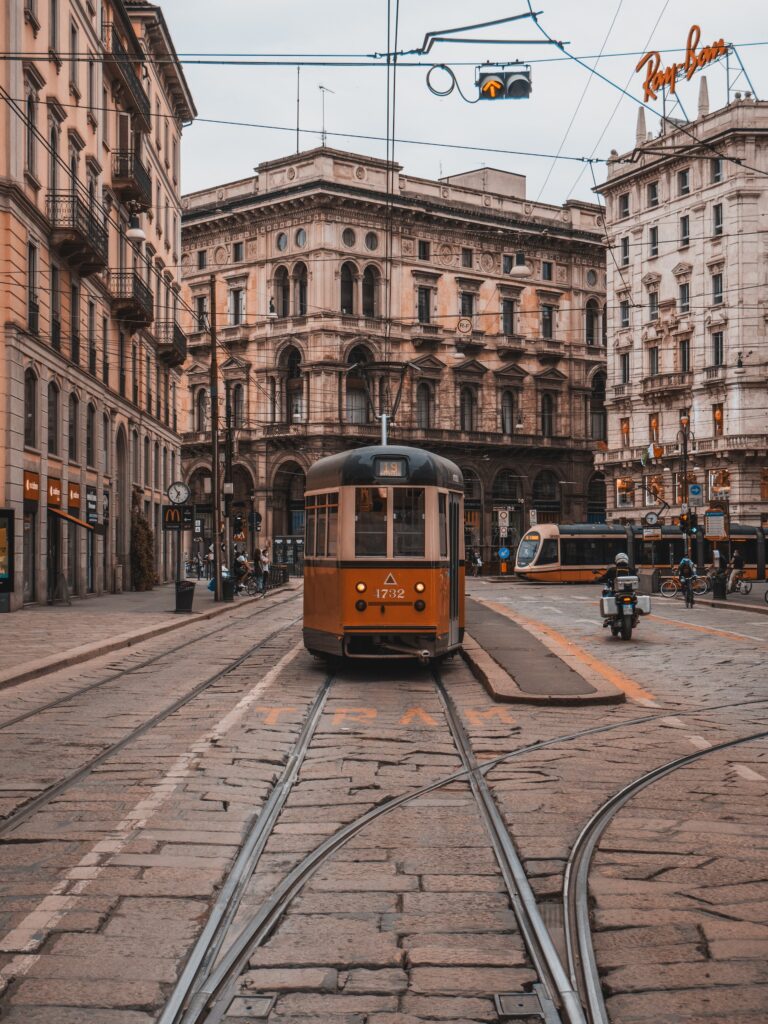
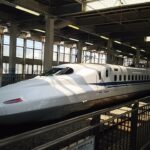

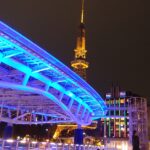


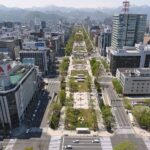
1 thought on “Milan Metro”